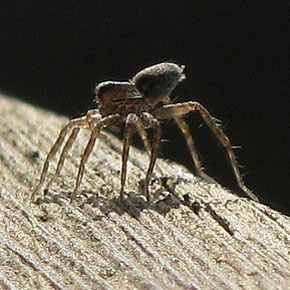Fall is a Fine Time for Ballooning Spiders
By Chris Williams on October 7, 2013.
 Did you know that spiders can fly? Spider flight is actually called “ballooning” and, for spiders, it’s more like traveling by parachute. The spider climbs to a high spot, lifts its butt to the air while releasing silk strands, and waits to be lifted off of its “feet” by a passing breeze. If all goes well, the spider sails off into space, buoyed by its silken parachute.
Did you know that spiders can fly? Spider flight is actually called “ballooning” and, for spiders, it’s more like traveling by parachute. The spider climbs to a high spot, lifts its butt to the air while releasing silk strands, and waits to be lifted off of its “feet” by a passing breeze. If all goes well, the spider sails off into space, buoyed by its silken parachute.
Spiders, as we know, spin silk from spinneret glands on their abdomen. The silk is used to make webs, trap and wrap prey, protect egg sacs, line burrows, escape from enemies, and travel to new locations (See How Do They Do That? – Spider Webs). It’s usually the smaller and newly hatched spiders that balloon since they are relying on breezes to carry their body weight. Adult spiders occasionally balloon to migrate to new locations, often when seeking a mate. But most of the ballooning is done by newly hatched baby spiders whose first imperative is to move to a new location. If they don’t get out of town, they risk being eaten by a cannibalistic sibling.
Spider ballooning is sometimes a dramatic event when large numbers of spiders decide to disperse at the same time, usually as a result of weather conditions. Observers rarely notice a single little spiderling floating along on its strands of silk. But when numbers of spiders balloon together, their strands stick to each other, forming thicker, floating silken mats that can be easily seen.
Ghostly Apparitions Just in Time for Halloween
Fall is a prime time to witness spider ballooning. In Dallas recently, news stations were buzzing with reports of ghostly, silky strands floating everywhere around the city. At the Chicago Hilton, guests in the high rise hotel received a flyer warning them to keep their windows shut “to avoid the annual migration of high rise flying spiders.” Spiders that would normally live on rocks overhanging water have instead adopted the rooftops of lake shore high rises as their substitute home.
Spiders don’t have any control over their flight–how high, how far, how long—or where they land. They’re at the whim of breezes and thermals. For most, it’s a short trip and many spiders die during ballooning. For others, it can be a thrilling ride as they sail up and away into the jet stream. Spiders have been collected by traps on airplane wings at altitudes of 15,000 feet. Others have been detected in atmospheric data balloons floating at 16,000 feet above sea level. Spiders have been known to survive traveling in the jet stream without food for more than 25 days. Ballooning is the main way in which spider species colonize isolated islands and reach mountaintops.
Photo credit: animakitty / Foter / CC BY-NC-ND